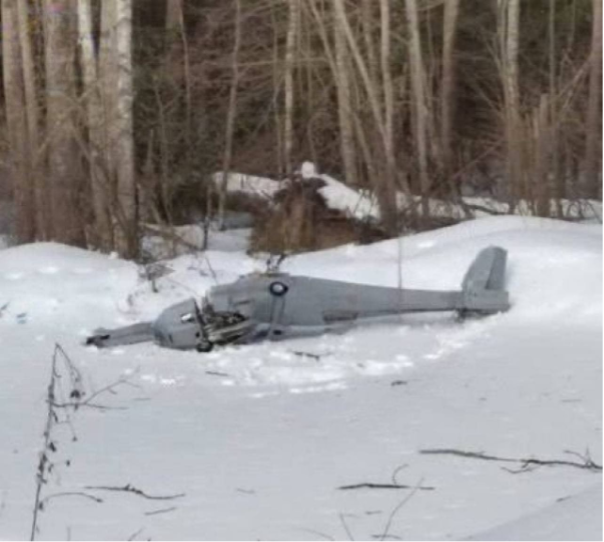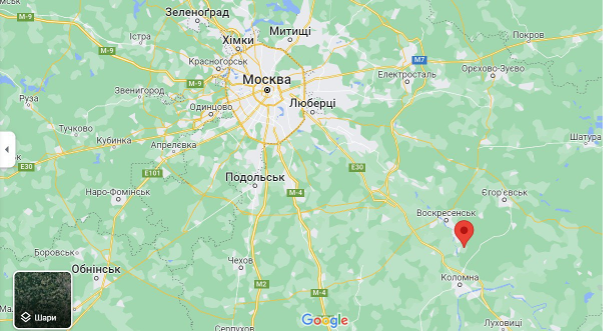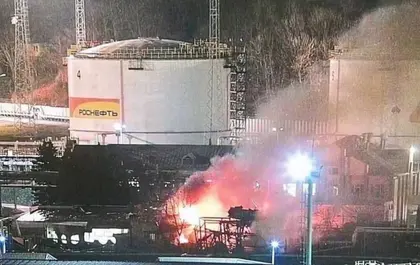Russian authorities grappling with “an unidentified flying object” above Petersburg and Ukrainian kamikaze drones boring in on the Black Sea port Tuapse on Tuesday launched interceptor jets and fired anti-aircraft missiles, as air raid warnings possibly engineered by Ukrainian hackers rattled millions of radio listeners in at least five major Russian cities.
Officials in the Black Sea port Tuapse in official statements said at least two Ukrainian strike drones entering Russian air space from the West during nighttime hours were tracked and shot down by local air defenses. The city is approximately 400 kilometers (about 260 miles) from the nearest probable Ukrainian drone launch site.
JOIN US ON TELEGRAM
Follow our coverage of the war on the @Kyivpost_official.
Russia’s state-controlled news agency TASS claimed the two kamikaze aircraft touched off a “small” fire on the territory of the port’s oil transshipment base but the blaze “did not affect the oil reservoirs.”
Tuapse Mayor Sergei Boyko in a Telegram statement confirmed a pair of drones exploded at the oil base but that no one was hurt and that a subsequent blaze covering about 200 square meters of the oil base’s territory was “quickly extinguished.” A statement from the Tuapse city council called on citizens “not to transmit fake information” about the Ukrainian attack.

British Defence Intelligence Update Ukraine 23 December 2024
Local Russian social media channels showed images of at least two anti-aircraft missiles launched into the night sky shortly after 2 a.m., rubble, debris and wrecked support girders from a destroyed electric power building on the base.
Other photographs and video showed smoke boiling hundreds of meters into the air. The Russian independent information platform Astra said the oil base is operated by the Russian state energy monopoly Rosneft, and that a Russian military barracks is located 30 meters from where the drones blew up.
Tuapse residents claiming to be eyewitnesses, in unconfirmed social media comments, said they saw a pair of flashes lighting up the horizon followed by two “loud explosions” without a blast wave.
Later Tuesday morning, in air space surrounding Russia’s second-biggest city St. Petersburg, authorities declared a region-wide air raid emergency following detection of a single “unidentified flying object” inbound from the west. A major port, industrial center, military base and Russian President Vladimir Putin’s hometown, St. Petersburg is 900 kilometers (about 560 miles) away from the closest probable Ukrainian drone launch sites.
The air raid warning grounded or turned back all civilian flights using Petersburg airports, and at least two Russian air force fighter jets launched and seemed to be searching for the incoming flying object, Russian independent news platforms reported, citing official sources and international flight data tracking platforms such as Flightradar.
The air space lockdown covered a 200-kilometer radius circle around Petersburg and lasted from approximately 9:30 a.m. to midday, Moscow time, news reports said.
A late-morning Russian Defense Ministry statement said air defense units in the west of the country had been conducting a training exercise, without commenting on reports of the alleged drone.
Independent Russian air traffic monitors were quick to point out that the official line of a planned air defense exercise was unlikely, citing aircraft tracking data showing even Russian government passenger aircraft en route to St. Petersburg from the Russian capital suddenly turned back once the official air raid warning order went into effect. The Russian non-government news platform Baza reported the warning was triggered after air defense radars in Russia’s west picked up data similar to an incoming drone.
The normally pro-Kremlin information platform Readovka on Tuesday afternoon posted images of Russian officials cordoning off a rural road southeast of Moscow following the crash of a Ukraine-manufactured UJ-22 Airborne drone in the vicinity.
Anton Gerashchenko, a usually well-informed Ukrainian Interior Minister official, in a Tuesday afternoon statement said the drone crashed “ten meters from the gas compressor station Voskresensk,” near the village Gubastovo, in Russia’s central Kolomensky region, south-east of Moscow. He did not offer information on the drone’s origin but made public an image, he said, that was of the crashed aircraft.
Russian authorities on Tuesday were also rattled by a wave of reports from cities Belgorod, St. Petersburg, Moscow, Omsk and Saratov of the apparent hacker takeover of morning radio programs, and the broadcast of faux air raid warnings in place of normal go-to-work content.
“Attention! Attention! An air raid warning is in effect! All should quickly take cover in bomb shelters!” a woman’s voice warned.
Pro-Kremlin Russian journalist German Kulikovskiy in Monday comments said Ukraine’s military leadership was sending drones into Russian air space to undermine public confidence in the Kremlin’s conduct of the war, in preparation for a major Ukrainian ground offensive in the Spring.
“We should look at this as preparation for the Spring offensive of the Ukrainian army, whose goal with attacks like this is to destabilize our (Russian) rear areas and to incite mass panic among Russians. Right now, Kyiv strategists are watching the reaction of our (Russian) leadership, and the capabilities of our air defenses and cyber defenses,” Kulikovsky said in a Tuesday Telegram post.

Ukrainian Interior Ministry official Anatoly Gerashshenko on Tuesday posted this image of what he called a drone that entered Russian air space and crashed near a gas fuel processing plant south-west of Moscow.

Purported location of the crashed drone that, according to Ukrainian Interior Minister official Anatoly Gerashchenko was an unidentified flying aircraft responsible for triggering air raid alarms in north-west Russia.
You can also highlight the text and press Ctrl + Enter






